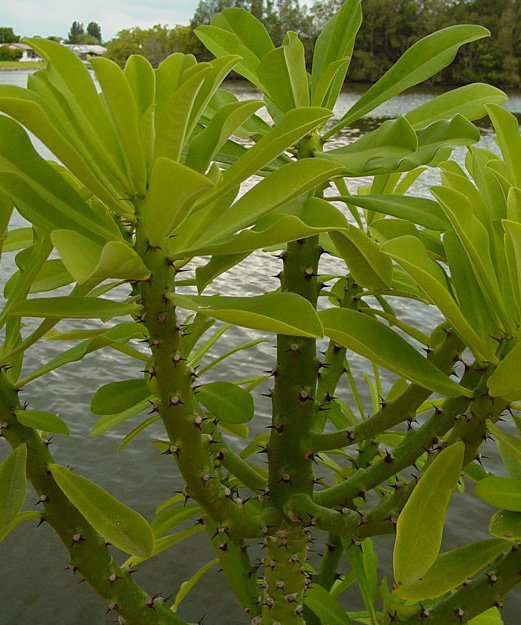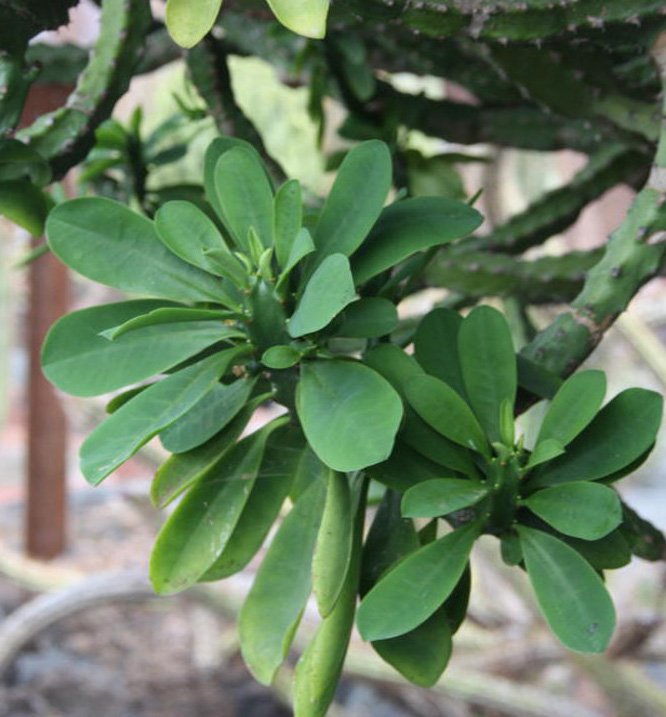Snuhi (Euphorbia neriifolia) Medicinal uses and pharmacology

Snuhi- Euphorbia neriifolia, also called Sehund, is an Ayurvedic herb used for the treatment of swelling, for purgation, cough, rhinitis and piles.
Latin name- Euphorbia neriifolia Linn.
Family- Euphorbiaceae
Names in different languages:
Hindi name-Sehund, Danda thukar
English name- Common milk hedge
Arabic name- Jakum
Kannada name- Male kalli
Marathi name- Thor
Malayalam name- Illa kalli
Punjabi name- Thor
Telugu name- Akujemuddu
Tamil name- Ilaikalli
Morphology of Euphorbia neriifolia:
It is a small tree or big shrub growing to a height of 10-20 feet in dry regions of India. The genus has over or about 2,000 members. The trunk and the branches are modified into round or irregular shape. The leaves are shrunk into spikes, fleshy in nature. Flowers when viewed as a whole, looks like a single flower. It has a unique kind of pseudanthium, called a cyathium, where each flower in the head is reduced to its barest essential part needed for sexual reproduction. These flowers have no sepals, petals, or other parts that are typical of flowers in other kinds of plants. The fruits are 0.5 inch long. Flowers and fruits are seen in the spring season.
Snoohi medicinal properties:
Rasa (Taste) – Katu (Pungent)
Guna (Qualities) – Laghu (Light for digestion), Teekshna (Strong)
Vipaka – Katu (Undergoes Pungent taste after digestion)
Veerya (Potency) – Ushna (Hot)
Karma (Actions) – Kaphavata shamaka (reduces vitiated kapha and vata dosha)
Part used- Root, Leaf, Milky latex
Dosage-
Root powder- 0.5 to 1 g
Stem juice- 5 to 10 ml
Milky latex- 125-250 mg
Chemical composition of Euphorbia neriifolia:
The triterpenoids, euphol, 24-methylene cycloartenol, euphorbol hexacosonate, glut-5 (10)-en-5-one, glut-1- en-3 beta-yet-acetate, taraxerol, friedelan-3 alpha-ol and–3 beta-ol have been reported from the plant.

Uses of Snuhi:
- The leaf of Snuhi is heated and tied over the area affected with pain and inflammation.
- The fresh juice from the leaf is poured inside the ears to treat earache.
- Oil processed from the leaf of Snuhi and sesame oil is used for external application to treat joint pain.
- The fresh milk latex of Euphorbia neriifolia is applied over external pile mass to reduce it.
- Milk latex is used in the preparation of ‘Kshara sutra’, a medicated thread useful to treat piles and fistula.
- Juice from fresh stem of Snuhi is added with honey and borax to treat cough and sore throat.
- The milk latex of Euphorbia neriifolia is applied over warts as part of treatment.
- The milk latex can cause purgation; hence it is used for cleansing the abdomen in cases of poisoning and in severe constipation.
- The paste of the leaf of Snuhi is applied over the skin to treat skin diseases.
Traditional uses of Sehund as per Ayurveda:
Deepana – improves digestion strength
Rechana – induces severe purgation
Anilapaha – Vatahara – useful in treating disorders of Vata Dosha imbalance such as neuralgia, paralysis, constipation, bloating, etc
Snigdha – unctuous, oily
Laghu – light to digest
Indicated in –
Shoola – abdominal colic pain
Ama – A product of indigestion and altered metabolism
Kaphaja gulma – tumor of Kapha origin
Udara – ascites, enlargement of the abdomen
Unmada – Schizophrenia
Meha – diabetes, urinary tract disorders
Kushta – skin diseases
Arsha – haemorrhoids
Shotha – Swelling, inflammation
Meda – obesity, high cholesterol
Ashmari – Kidney and bladder stones
Pandu – anemia
Vrana – Ulcers, wounds
Adhmana – bloating, gaseous distension of abdomen
Jwara – fever
Pleeha – Disease of the spleen, Splenomegaly
Visha – Toxic conditions, poisoning
Dooshivisha – chronic poisoning
Dushta Vrana – infected wound
Snuhi variety, called Shatala, with synonyms Saptala, Sara, Vimala, Vidula yields profuse latex with frothing. It is Katu – pungent
Tikta – bitter
Indicated in
Shotha – Swelling, inflammation
Kapha Anaha – bloating, fullness
Udavarta – bloating
Raktapitta –Bleeding disorders such as nasal bleeding, heavy periods, etc
Side effects of Snuhi:
Excess use of Snuhi can cause severe purgation and if the milk of the plant falls to the eye, it can cause blindness. Hence Snuhi should be used always under medical supervision.
Ayurvedic medicines containing Snuhi:
Agnivrana Taila: It is an Ayurvedic medicated oil used for the treatment of burns, boils, prevention of the blisters etc.
Ayaskirti: It is an Ayurvedic medicine used for the treatment of anemia, weight loss therapy, skin diseases, irritable bowel syndrome etc.
Vishatinduka taila: It is an Ayurvedic medicine used for the treatment of Gout, numbness, skin diseases with discoloration. The oil is applied externally.
Abhaya lavana: It is an Ayurvedic medicine, used in the treatment of liver and spleen disorders. It is in powder form.
Madhusnuhi rasayana: It is a formulation used in the treatment of skin diseases like eczema, psoriasis, diabetic carbuncles, fistula, piles, tumors, goiter, itching, rheumatoid arthritis and non- healing wounds.
Ardraka ghrita: It is a medicine in ghee form and is useful to treat indigestion, chronic diarrhea, gastritis etc.
Arsha kutara rasa: It is an Ayurvedic medicine in tablet form. It is used in the treatment of hemorrhoids.
Jalodarari rasa: It is an Ayurvedic medicine used in the treatment of ascites and hepatic disorders.
Shanka dravaka: It is an Ayurvedic medicine used for the treatment of ascites, indigestion, diseases of the liver and spleen.
Research articles related to Euphorbia neriifolia:
Anti- microbial study: The phytochemical analysis of leaf extracts (chloroform, ethanol, ethyl acetate, butanol and aqueous) of a medicinal plant, Euphorbia neiirifolia and their antibacterial activities against bacterial isolates, Staphylococcus aureus, Klebsilla pneumonia, Escherichia coli, Proteus vulgarius, Pseudomonas fluroscens were investigated. the presence of flavonoids, phlobatannins, saponin, tannins, cardenoloids, phenol, terpenoids. The maximum activity was observed in chloroform extract against P. vulgarius with zone of inhibition (8 mm), followed by ethanol extract against K. pneumonia (5 mm). This research supports the local use of the leaf of the plant, E. neiirifolia for wound healing property and other forms of bacterial infections.
Protective action on induced thrombosis: The present work was designed study antithrombotic potential of E. neriifolia Linn. Carrageenan-induced rat tail thrombosis model was used to study the anti-thrombotic effect by measuring thrombosis of tail and bleeding time as well as clotting time. In the present work, phyto-constituents like flavonoids and polyphenols could be responsible to demonstrate protective effect on experimentally induced thrombosis in murine model.
Wound healing activity: The wound healing effect of aqueous extract of the latex of Euphorbia neriifolia was evaluated in guinea pig. Surgically produced cutaneous wounds were treated with topical application of 0.5% and 1 .O% sterile aqueous solution of the extract. The extract facilitated the healing process as evidenced by increase in tensile strength, DNA content, epithelization and angiogenesis.
Antioxidant action:The antioxidant activity of EN extract was evaluated by various antioxidant assays such as TAC, FRAP, FTC, TBA and non specific activity. All these antioxidant activities were compared with standard antioxidants. Phytochemical screening and the total phenolics, flavonols and
proanthocyanidin content were also determined. A positive correlation between the antioxidant
activities and physiochemicalassays was observed and the highest scavenging activity of extract was noticed at concentration of 1mg/ml.
Liver plays an important role in the metabolism of drugs and it is the most vulnerable tissue for drug toxicity. According to the reports published by U.S. Food and Drug Administration, more than 900 drugs, toxins and herbs have been reported to cause liver injury. Drugs account for 20-40% of all instances of hepatic failure.
DENA, one of the most important environmental carcinogen and has been reported to cause the generation of ROS resulting in oxidative stress and cellular injury. As liver is the major site of DENA metabolism, the production of active oxygen species in the liver may be responsible for its carcinogenic effects. They have reported that a cell cycle disturbance induced in DENA-initiated hepatocytes by colchicine gives a growth advantage to putative preneoplastic lesions under conditions of partial hepatectomy and selection pressure and hence that a high incidence of HCCs can be obtained within a short latent period corroborating over present finding.[19]
Observed results depict that the DENA exposed group showed 100% tumor incidence and these results are in agreement with aforementioned findings of previous workers. The results are also showed that administration of HEEN (at high dose) and ENF could prevent DENA-induced hepatic carcinogenesis in mice as no malignancies were seen in the animals.
Histopathological examination of liver section of normal mice showed normal hepatic cells with well-defined cytoplasm and nucleus, whereas DENA exposed group showed liver cells were completely damaged and depicted pathological changes such as steatosis, centrilobular necrosis, large vacuolization, hyperchromatic malignant nuclei, hyperplastic nodules and obvious heteromorphism. These results are in confirmation with the findings of previous workers. The resulting effect was the production of elevated amounts of malondialdehyde and conjugated dienes, which caused deleterious effects on the membranous components of hepatocytes.
HEEN (at both dose) and ENF pre-treatments before intoxicated with DENA (Groups III, IV and VII) showed the recovery process as indicated by the marked regenerative activity with mild necrosis (Day 31) and the cells became normal. The normalization of histo-architecture of liver damaged by DENA in ENL, ENH and ENF groups might be due to the trapping of ROS directly or indirectly by HEEN and flavonoid. Our results are in agreement with the previous report.[22] Observed results also revealed that BHA (at both dose) alone showed some mild distortion along with necrosis and swelling of the liver tissue as compared with the control group. BHA at both dose levels before intoxicated with DENA tried to revert, but not much extent as by HEEN and ENF group.
The mice treated with the hydro-ethanolic extract and isolated flavonoid before intoxicated with DENA the normal cellular architecture was retained and it is more efficient than the standard BHA (at both dose) group, hence confirming the significant hepato protective effect of extract of HEEN at the dose of 150 and 400 mg/kg body weight and ENF at 50 mg/kg body weight, which is also confirmed by the results of biochemical studies.
In this study, E. neriifolia act as antioxidant agent as this plant contained wide range of active ingredients such as sugar, tannins, flavonoids, alkaloids, triterpenoids, tetracyclic triterpene (nerifoliene and euphol), triterpenoidal saponins etc.,[26,27,28] which can inhibit or slow down the severity of cancer. These active ingredients especially flavonoids, terpenoids and saponins neutralized free radicals and intermediates of metabolism that are highly reactive since they contain a non-paired electron[30] and to be responsible for the observed protective histological effects. The present study findings provide and validate the scientific evidence to the ethnomedicinal therapeutic use of this plant.
The results presented in this study conclude that hepato-carcinogenesis, which was induced by DENA was effectively inhibited by 70% hydro-ethanolic (v/v) extract of E. neriifolia and by flavonoid isolated from ethanolic extract of E. neriifolia. The result could also be expressed in the order of ENH> ENF> ENL> BHAH> BHAL.
Classical categorization:
Dhanvantari Nighantu- Guduchyadi varga
Bhavaprakasha- Guduchyadi varga
Raja Nighantu- Shalmalyadi varga
Kaiyyadeva Nighantu- Oushadhi varga
Shodala Nighantu- Guduchyadi varga
Sanskrit Synonyms of Snuhi:
Sudha- Has white colored latex
Samanth dugdha- Has milk all over the body
Vajradruma, Vajrakantaka, Kulisha Druma, Vajravruksha, Vajratunda, Vajri- It has strong action like diamond, branches are diamond shaped in cross section
Nistrisha patra- The structure is sharp like sword
Mahavriksha- The shrub grows to a good height
Vatari – balances Vata Dosha.
Ksheerakanda, Bahushrava – Yields profuse latex
Vyaghranakha, Guda, Gudakhya, Gandeera, Sehunda, Snuk, Snuhi, Sihunda, Nihunga, Simhatunda, Shakhakhanda,
Bahushakha – multiple branches
Dandavruksha – branches are like log of woods

